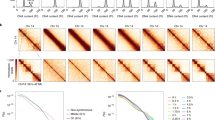Summary
Treatment of human and mouse cell cultures with the cytidine analogue 5-azadeoxycytidine and the AT-specific DNA ligand Hoechst 33258 dramatically inhibited condensation of the pericentromeric heterochromatin in several chromosomes. When stained with antikinetochore autoimmune sera, these experimentally undercondensed chromosomes showed kinetochores with preserved antigenicity. The undercondensed and normally condensed chromosomes share the major antigenic determinants of the kinetochore.
Similar content being viewed by others
References
Brinkley BR, Zinkowski RP, Mollon WL, Davis FM, Pisegna MA, Pershouse M (1988) Movement and segregation of kinetochores experimentally detached from mammalian chromosomes. Nature 336:251–254
Earnshaw WC, Halligan N, Cooke C, Rothfield N (1984) The kinetochore is part of the metaphase chromosome scaffold. J Cell Biol 98:352–357
Earnshaw WC, Machlin PS, Bordwell BJ, Rothfield NF, Cleveland DW (1987) Analysis of anticentromere autoantibodies using cloned autoantigen CENP-B. Proc Natl Acad Sci USA 84:4979–4983
Haaf T, Schmid M (1989) Centromeric association and non random distribution of centromeres in human tumour cells. Hum Genet 81:137–143
Haaf T, Steinlein K, Schmid M (1986) Preferential somatic pairing between homologous heterochromatic regions of human chromosomes. Am J Hum Genet 38:319–329
Hilwig I, Gropp A (1973) Decondensation of constitutive heterochromatin in L cell chromosomes by a benzimidazole compound (“33258 Hoechst”). Exp Cell Res 81:474–477
Lica LM, Narayanswami S, Hamkalo BA (1986) Mouse satellite DNA, centromere structure, and sister chromatid pairing. J Cell Biol 103:1145–1151
Peretti D, Maraschio P, Lambiase S, Lo Curto F, Zuffardi O (1986) Indirect immunofluorescence of inactive centromeres as indicator of centromeric function. Hum Genet 73:12–16
Rieder CL (1982) The formation, structure, and composition of the mammalian kinetochore and kinetochore fiber. Int Rev Cytol 79:1–58
Schmid M, Haaf T, Grunert D (1984) 5-Azacytidine-induced undercondensations in human chromosomes. Hum Genet 67:257–263
Vig BK, Zinkowski RP (1985) Sequence of centromere separation: influence of pericentric heterochromatin (repetitive DNA) in mouse. Genetica 67:153–159
Yunis JJ, Yasmineh WG (1971) Heterochromatin, satellite DNA, and cell function. Science 174:1200–1209
Zinkowski RP, Vig BK, Broccoli D (1986) Characterization of kinetochores in multicentric chromosomes. Chromosoma 94:243–248
Author information
Authors and Affiliations
Rights and permissions
About this article
Cite this article
Haaf, T., Schmid, M. Kinetochore formation in experimentally undercondensed chromosomes. Hum Genet 84, 535–538 (1990). https://doi.org/10.1007/BF00210805
Received:
Revised:
Issue Date:
DOI: https://doi.org/10.1007/BF00210805




